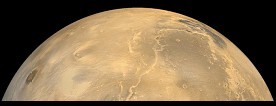|
| Windows on Mars is a first-of-its-kind video about the relationships of the arts and sciences as they apply to NASA's plans to establish a habitat on Mars in 2030. It provides teachers, students, and others in both formal and informal learning environments with insights and thought-provoking questions and ideas for participation in the Mars Society EduPortal. The video is specifically designed to enhance use of the Project Activity Guide, which has been provided in hard copy to more than 100,000 teachers and schools and electronically to a growing number of visitors to the Mars Society EduPortal Web site. Here are suggestions for using the video to help students in schools and young persons in out-of-school settings combine the realities of scientific principles concerning travel to and life on the Red Planet with the imaginative power of the arts to enhance living and working both here and on distant planets. Ellen Kochansky, an artist featured in the video, summarizes the challenge for Mars Project participants in designing the Mars habitat when she observes that "the beautiful must be necessary, and the necessary must be beautiful." The Arts on Mars:The video is divided into four segments (ranging from just under 10 minutes to 18 minutes) based on experiences in art and architecture, music, storytelling and folk arts, and dance. Teachers and other project leaders can use one or all of the segments in any order to support lesson plans and units. Depending on the interests of participants, the segments can stimulate brainstorming about how a particular art discipline or form can be adapted to the planned Mars habitat. Here are questions that the four segments address:Art & Architecture:
Reflect, Imagine, Discover, Create, & ShareDepending on where teachers and students are in imagining and creating their habitat for Mars, the video's segments can be used to support all five suggested steps of project participation explained in the Activity Guide: Reflect, Imagine, Discover, Create, and Share.Use the video to discover and research how scientists and artists view the potential of living on Mars. Step 3 in the Activity Guide to Mars2030, Discover, suggests that participants seek out scientists, artists, and others who understand issues that are key to the project. Windows on Mars brings 17 nationally and internationally recognized artists as well as 11 scientists from NASA and the Jet Propulsion Laboratory to your classroom. The dialogues between scientists and artists that are at the heart of the video will lead to rich discoveries for Mars2030 Project Teams. Windows on Mars is an excellent resource for exploring topics listed under each of the "big questions" developed by the Arts Endowment and NASA for the Activity Guide (requires the free Adobe Acrobat Reader): Question 1: What is a community? Suggested topics include the role of arts and artists in past communities, societies, and civilizations. Through the sharing of tales that can be traced back generations, modern-day storytellers convey time-honored lessons and insights about the human spirit that are instructive whether we are here on Earth or part of a small, history-making community on Mars. Question 2: How would your community be different on Mars? Includes a number of topics from both the arts and sciences perspectives: The relationship between artists and their audiences is explored as well as the topics of atmosphere, energy sources, and the prospects for building performing arts facilities and other habitable spaces. At the outset of the video, we learn that it will cost at least $50,000 per pound to carry materials to Mars. Thus, what might begin as a mathematics problem can be continued as a larger problem-solving exercise involving adaptations to architecture and design, recycling, electronic music, and a number of other things Mars Project Team participants must image anew or adapt from known processes and products here on Earth. Question 3: What makes life in your community meaningful? Suggests explorations of such topics as architecture and design and the way in which artistic expression and communications convey ideas and feelings as well as how we meet physical needs such as air, water, food, and a place to live as a society. In Windows on Mars, architects discuss how the natural landscape and indigenous minerals can be fashioned into a functional as well as aesthetic living environment. Storytellers, musicians, and visual artists provide insight about the traditions, sights, and sounds in our everyday lives that provide creative ideas and inspirations for expressing ourselves and making meaning as individuals and communities. Question 4: How would you create and represent your Mars community? This poses the most challenging question: What will you and your students choose to represent the habitat you foresee for Mars in 2030. Windows on Mars provides practical as well as imaginative approaches for participants. The interpretation of the Mars Rover landing by the Lula Washington Dance Group, for instance, will inspire those who may want to portray aspects of their habitat through choreography and dance. Similarly, students of music will be inspired to include compositions that spring from the indigenous sounds of the Red Planet after seeing and listening to compositions by Morton Subotnick and Kelvin Miller in the "Music On Mars" segment of the video. |
